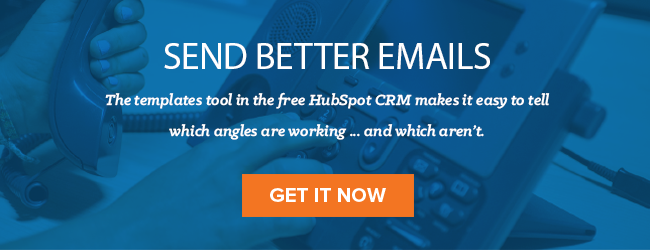How to Close With Modern Closing Techniques
Adjournment Close
How it works: When you can tell your prospect isn’t ready to make a decision, give them more time to think rather than pushing for the close.
Why it works: Most buyers expect you to take the stereotypical, overly aggressive approach. Understanding it's not in their best interest to decide immediately will earn you their trust; plus, research shows the deal is usually bigger since you don’t need to resort to discounting.
What it sounds like: “I know this is probably an important decision for [company], and I don’t want to rush you. Should we schedule a call for tomorrow?”
Artisan Close
How it works: Highlight how much work, skill, thought, and/or time has been invested into the product you’re selling.
Why it works: The more difficult or labor-intensive something is to make, the more someone will value it. Intuitively, this makes sense -- but reps often forget their prospects typically don’t have the same context or product knowledge as they do.
What it sounds like: “We have 10 people whose sole job is upgrading the dashboard so it’s as easy to read as possible. That’s more than any other company in this space.”
Ask-the-Manager Close
How it works: Rather than requesting a discount for your prospect and telling them it’s been approved, let them know you’ve asked. Then, once your manager says yes, tell your prospect the good news.
Why it works: Showing your prospect you’re willing to compromise on price and work on their behalf boosts your credibility. In addition, they’re likelier to make their concessions of their own.
What it sounds like: “I can’t authorize a discount of that size, but my manager can. Let me ask her if we can do that for you.”
Three hours later: “Happy to say my manager gave us the green light. The new price would be …”
Balance Sheet Close
How it works: Tally up the benefits and drawbacks of the purchase so the buyer gets a sense of your product’s value and why they should buy.
Why it works: Your prospect is already making a pros and cons list -- either mentally or on paper. By doing it for them, you get to control the process while building their trust. You can also make it explicitly clear the payoff outweighs the risks or disadvantages.
What it sounds like: “Let’s go over the pros and cons of using our employee management platform. On the one hand, you’ve already got a system up and running. Your employees might not be thrilled about switching. It’ll take a few weeks to export your data and train them how to use the new tool. But as we’ve calculated, you’ll save at least $1,000 per week. It’s also much easier to use than your existing platform, according to the customers who have switched, and comes with 24/7 support.”
Best Time Close
How it works: Emphasize the importance of buying right now. In other words, appeal to your prospect’s sense of urgency.
Why it works: It’s incredibly difficult to change, which is why salespeople lose to the status quo more than the competition. Encourage your prospect to act now, while they’re as motivated as they’ll ever be to buy. Time kills sales deals.
(Of course, that doesn’t mean manufacturing a reason. Act unethically, and you’ll lose future customers thanks to negative word-of-mouth. Look for a genuine reason the buyer needs your solution ASAP. If it’s a good fit, that shouldn’t be hard to do.
What it sounds like: “If you want this in place for your next customer event, we need to finalize the contract by the end of the week.”
Calendar Close
How it works: Instead of going for the ultimate close, which your prospect often isn’t ready for, request a future meeting. This keeps the momentum going.
Why it works: Getting a specific commitment from the buyer is key. It’s much likelier you’ll get back on the phone with them if you’ve agreed to a date and time before your current call has ended -- and if your prospect won’t schedule another, they’re probably not serious in the first place.
What it sounds like: “Next, I usually meet with the customer’s end users to learn about their day-to-day processes. Are two or three people on your finance team free next Wednesday?”
Conditional Close
How it works: Set up a quid pro quo agreement. If you agree to your prospect’s condition, they’ll concede one of your points.
Why it works: This strategy leverages your prospect’s sense of fairness and shows you’re willing to compromise to arrive at a mutually satisfying agreement.
What it sounds like: “Our agreements are typically multi-year. However, if you pay for six months upfront, I can give you a one-year contract.”
Cost of Ownership Close
How it works: Calculate the total cost of owning your product, including implementation, services, maintenance, upgrade fees, and so on. Then contrast that to a competitor’s products. If applicable, demonstrate how a small difference in cost adds up over time.
Why it works: It’s easy to focus on the sticker price and forget about the bigger picture. Using this technique ensures the buyer sees the latter.
What it sounds like: “Competitor X is $200 cheaper, but their monthly support costs $50 more. You’ll ‘break even’ in four months. Eight months after that, you’ll have saved $400 over the competition.”
Customer Care Close
How it works: After you’ve lost a deal, wait an appropriate amount of time before reaching out to the prospect to ask about their buying experience.
Why it works: Showing interest in your prospect’s opinion makes them feel important and respected. It also suggests your company cares about its customers, which may convince them to change their mind. Additionally, you’ll get valuable intel into their reasoning that may come in handy for the account, not to mention your other deals. Even if this prospect doesn’t reverse their decision, you’ll have set the stage for a future purchase.
What it sounds like: “Hi Saria, I was wondering if you’d be willing to answer a few questions about working with me in February. I’m always trying to improve, and this would be really helpful. Did I give you enough information? Was the speed of the process okay? Were there any objections or concerns I didn’t appropriately resolve? How could I have done a better job?”
Weekly Cost Close
How it works: Calculate how much your product will cost per week (or day, or month).
Why it works: The solution will seem more affordable once it’s been divided into smaller pieces. You can even compare the reduced price to a common everyday purchase, like a cup of coffee or a movie ticket.
What it sounds like: “This costs just a dollar per day, which is like buying one employee a bagel.”
Needs Close
How it works: List everything the buyer has said they’d need in the product. Then review your product against that list.
Why it works: Checking off each box in short succession proves your product is a good fit. You might not be able to meet every single one of their desires, but the buyer will likely conclude it’s still a good purchase.
What it sounds like: “Let me make sure I’ve gotten everything you’re looking for. You need a tool that’ll let you schedule texts to your customers, tie revenue to individual text messaging campaigns, and easily review performance through metrics like response rate and CTR. Did I miss anything? Great. Well, let’s see. Happn offers scheduled SMS messages to 1,000 contacts, comes with advanced analytics so …”
Negative Consequences Close
How it works: Describe the undesirable ramifications of doing nothing using the information your prospect gave you during the discovery process.
Why it works: Fear, Urgency, and Doubt (FUD) tactics can drive the buyer to pull the trigger. It’s an effective way to help them overcome their hesitations, but make sure you’re using it ethically. Only describe real consequences.
What it sounds like: “You currently service 462 locations in 80-plus counties. If a single supply route is disrupted -- which according to the stats you gave me, happens roughly every two years -- you’ll lose access to at least one-third of those. That could cost you $1 million in revenue if you’re being conservative.”
No Hassle Close
How it works: Complete as much of the buying process as possible for your prospect. For example, sign out the paperwork, forward materials to Legal in advance, meet with Procurement to settle on a mutually satisfactory price, and so on.
Why it works: Getting rid of all the administrative details not only makes it incredibly easy for your prospect to say ‘yes,’ it also encourages them to buy in return for your help.
What it sounds like: “I just emailed you a TechReview comparison of our product versus Nectea that you can show to your boss. It’ll help her understand why Nectea isn’t the best choice if you want to use the same app at twice your current size. I’ve also sent you a product walkthrough video that she may be interested in watching.”
Quality Close
How it works: Instead of selling on price, highlight the value of your product. Emphasize how long it lasts, how easy it is to use, how infrequently it requires maintenance, how innovative it is, how well-designed they’ll find it, and so on.
Why it works: Most prospects are drawn in by price, but helping them understand value is more important in the long run will win you the deal -- without resorting to discounting.
What it sounds like: “Our product has 3% higher uptime than any of our competitors, which is hugely significant when you translate that to real hours.”
Reversal Close
How it works: Tell your prospect you’re not sure they’re a right fit. They’re smaller, less mature, and/or less established than your typical customer.
Why it works: People want what they can’t have, so suggesting your product is out of reach will naturally spark your prospect’s desire to buy it. This reverses the power dynamic -- rather than you selling them, they’re selling you. In addition, you’ll seem more credible and trustworthy because you’re not willing to take just anyone’s money.
It might go without saying, but don’t abuse this technique. It should be reserved for buyers who don’t meet your typical personas.
What it sounds like: “Full disclosure, John. Our customers usually employ 600-plus people and have dedicated training teams. Since your company is half that size, you might not be able to take full advantage of the product.”
Scale Close
How it works: Ask your prospect how interested they are in making a purchase on a scale from one to 10. After they choose a number, say you’re surprised -- you thought their number would be lower. Have them describe why they’d buy. Repeat their answers back to them. Then say you’re confused. If they’re so enamored with the product, why didn’t they say ‘10’?
Why it works: This strategy identifies your prospect’s top buying priorities and objections. It’s the perfect jumping-off point for a frank discussion of why the product fits their needs.
What it sounds like: “From one to 10, where 1 is ‘definitely not buying’ and 10 is ‘I want to buy immediately,’ what number are you?”
“I’m surprised you said [number], I would’ve guessed you were a [lower number]. Why did you pick [number]?”
“So, it seems like you chose [number] because of X, Y, and Z. But then if you have these great reasons to move forward, I’m wondering why you’re not actually a 10.”
Similarity Close
How it works: Describe a buyer who faced similar challenges who has seen a lot of success with your product.
Why it works: If the prospect is worried about the issues they’re experiencing, hearing about someone who overcame the same issues will quell some of their anxiety. It’ll also reinforce the connections you’ve drawn between their needs and the product’s features.
What it sounds like: “I worked with another company in the shipping industry last year. Like you, they had roughly 50 employees and struggled to hire more shore-based operation workers. After they started using the branding strategy we developed more them, their application rate nearly doubled.”
Testimonial Close
How it works: Rather than trying to convince your prospect of your solution’s benefits, sell through a happy customer. You can either use a written testimonial or an actual customer reference.
Why it works: An independent person or business is far more convincing than you’ll be, since they’re less biased. This process also builds up your trust and credibility.
What it sounds like: “I know you’re interested in our receipt feature, so I wanted to show you an email from one of our customers talking about how smooth their process became once they started using our tool.”
1-2-3 Close
How it works: Summarize the product’s features, benefits, or use cases in sets of three.
Why it works: According to changingminds.org, this close harnesses the “principle of triples”
-- “three things given together act as a coherent set of three hammer-blows that give a compelling message.”
What it sounds like: “Our tools will help you prospect, qualify, and close.”
Modern buyers can spot high-pressure closing tactics from a mile away. To sell in 2017, you need a strategy that’ll help them make a decision -- not manipulate them. These tactics will help you do just that.
Sales Closing






![Sales Close Plan: The Best Tool to Close Way More Deals [Template]](https://53.fs1.hubspotusercontent-na1.net/hubfs/53/sales-close-plan-1-20241125-8524726.webp)


![How Close Rates are Shifting in 2024 [New Data]](https://53.fs1.hubspotusercontent-na1.net/hubfs/53/close-rate.webp)
![Sales Pros Say This Tool is Key to Driving Sales: How to Close More Deals With It [Data]](https://53.fs1.hubspotusercontent-na1.net/hubfs/53/85_Best-Sales-Strategies.png)


